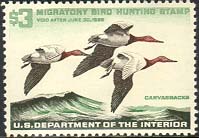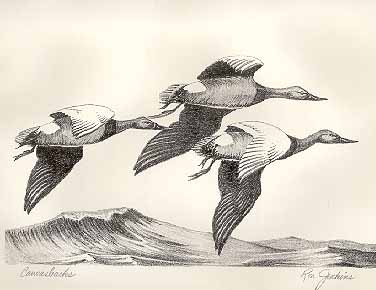

Back to RW32 Back to the Federal Index Home
A LITTLE HISTORY ON THE 32TH (1965-66) DUCK STAMP ARTIST


When his 1964 painting of Canvasbacks won the Duck Stamp contest, Ron Jenkins says his studio looked like "Fibber McGee’s" closet. It was overflowing with pictures and sketches of scenery and wildlife that he brought back from a trip he took to Wyoming in the summer of 1967. In a similar way, the time schedule of the 35-year-old artist was overflowing with interest and activities.
Ron Jenkins was a Pennsylvanian at the time but he was born in Pawtucket, Rhode Island on August 18, 1932. When he was only three years old he moved to Carlisle, Pennsylvania. He graduated from Carlisle High School in 1950 and has lived in the town every since.
Mr. Jenkins began free-lancing full time in July 1966. He has illustrated a number of stories for the Pennsylvania Game News and the Pennsylvania Angler, and did three covers for each of them in 1967. National Geographic magazine and the Modern Game Breeding magazine have also carried his work. His paintings appear in several private collections.
Mr. Jenkins enjoys doing lithographs as well as paintings. In addition to his Duck Stamp print, he has made a lithograph of a flying quail in a numbered and limited edition of 100. These were the same size as his Duck Stamp print, and when they first came out in 1967, they were available from him for $10.
Ron teaches art from time to time and gives speeches on art and conservation. He is a member of the Pennsylvania Outdoor Writers’ Association and the Outdoor Writers’ Association of America.
He left temporarily in January of 1951 to join the Marine Corps. After boot camp at Parris Island, he worked as a telephone lineman stringing cables through California, Korea and Quantico. He earned his sergeant’s stripes within three years. After he left the Corps in January 1954, he returned to his hometown and married a high school sweetheart, Marian Decker.
Throughout the academic year 1954-55, Mr. Jenkins attended the Philadelphia Museum School of Art. Because of increasing family responsibilities, he had to drop his art education, temporarily, to go to work for a savings and loan association.
By 1967 his "family responsibilities" were considerable. The Jenkins roof sheltered not only Ron, Marian, and a burgeoning studio, but five young boys ranging in age from 3 to 12, a hawk, and a dog. Of course, the "Fibber McGee" closet effect was probably augmented by hunting and fishing gear for six, an insect collection, assorted rocks, minerals and seashells, bicycles, sleds, boots, toys, and 313 mismatched mittens.
--------------------THE ART--------------------
Canvasbacks was painted in gouache photo retouch greys. A stone lithograph print was hand pulled on white Rives heavy weight paper using black ink. Nine prints were handcolored, signed and numbered in pencil; the remainder of the edition was signed only. The print image size is 5-1/4" x 9-1/2".
--------------------THE STAMP--------------------
Canvasbacks…Engraved by the Federal Bureau of Engraving. Printed in two different shades of Engraving. Printed in two different shades of brown and green ink. The stamp sold for three dollars. Postal records show 1,558,755 stamps sold. First day of sale was July 1, 1965.
Most of the information contained above is from the book Federal Duck Stamp Story, Fifty Years of Excellence, by Laurence F. Jonson; Alexander & Co. It is used here with permission from the author. For more information on this book, please click here.